Hip Hop Poetry and the Classics Pdf Answer Key
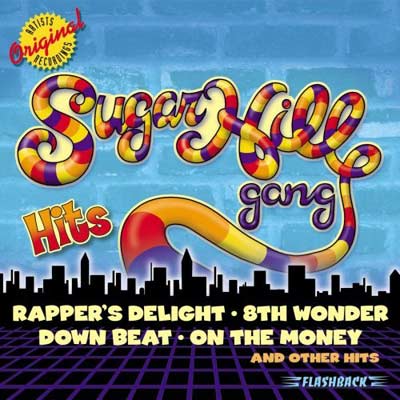
Photo courtesy Consumer Guide Products
The Sugarhill Gang's Rapper's Delight was the first hip-hop song to go gold.
"I said a hip hop
the hippie the hippie
to the hip hip hop, you don't stop the rock it
to the bang bang boogie, say up jumped the boogie
to the rhythm of the boogie, the beat"
It's possible you're at a crossroads right now between finishing the lyrics to this song and reading this article. Go ahead; sing a little more if you can -- we're right there with you …
"Now what you hear is not a test -- I'm rappin' to the beat
and me, the groove, and my friends are gonna try to move your feet
see I am Wonder Mike and I'd like to say hello
to the black, to the white, the red, and the brown, the purple and yellow"
Finished yet? No?
"But first I gotta bang bang the boogie to the boogie
say up jump the boogie to the bang bang boogie
let's rock, you don't stop
rock the riddle that will make your body rock …"
If you made it to this verse and still have more lyrics in you, then you probably know these are from one of the first hip-hop, or rap, songs ever recorded -- "Rapper's Delight" by The Sugarhill Gang. You might remember the song from when it first hit the airways sprinting toward gold, or maybe you're flashing to a little old lady in the Adam Sandler movie, "The Wedding Singer." While it's true that in October 1979 this was the first hip-hop song to garner gold, it by no means represents the beginning of hip-hop.
Global Graffiti
With the aid of the Internet, graffiti has gone global. Web sites like Art Crimes, @149st, Aero, Éiresol Style and many others unite taggers from around the world. Most sites include vast archives of photos, and you'll also find blogs, videos, articles, newsletters and interviews.
Another thing to clear up is this: If you think hip-hop and rap are synonymous, you're a little off the mark. While it's accurate to say that rap is hip-hop, it's not entirely accurate to say that hip-hop is rap. Hip-hop is a cultural movement akin to Art Deco and the Harlem Renaissance, and, much like these movements, it incorporates several elements. Most hip-hop historians speak of four elements of hip-hop: tagging (graffiti), b-boying (break dancing), emceeing (MCing) and rapping. One of the visual elements -- graffiti -- technically came first, but at that time it wasn't part of hip-hop culture because hip-hop didn't exist. DJing and MCing (and eventually rapping) started the hip-hop movement, with dance and style following closely thereafter.
If you look at the movement from its beginnings up to today, you'll see that these elements have expanded into broader terms:
- Visual art, which includes graffiti as well as other graphic arts and film
- The written and spoken word, which includes MCing, rapping and performance poetry
- Physical movement, which includes a variety of hip-hop dance styles
- Style, which includes clothing and other objects of fashion
Lyrics aren't the only words of the hip-hop movement. Poetry has also found a home in hip-hop, by way of spoken word -- the process of reciting original poetry or the work of another in front of a group or audience. It should be noted that performance poetry isn't confined to the realm of hip-hop, but it has steadily been gaining footing within the movement for many years. If you've seen an episode of Russell Simmons' HBO TV series, Def Poetry Jam, which premiered in 2002, then you know what it is. A number of noted poets and celebrities have appeared on the show, including Amiri Baraka, Ani DiFranco, DMX, George Clinton, Erykah Badu, Kanye West, KRS-One, Lou Reed, Nikki Giovanni, Smokey Robinson, Sonia Sanchez and Wyclef Jean.
In this article, we'll take a closer look at each of the elements of hip hop. But first, let's go back -- way back -- and explore the beginnings of this 30-year-old movement.
History of Hip-hop
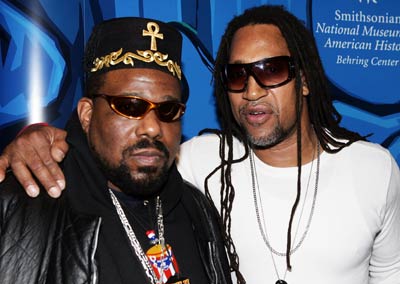
Scott Gries/Getty Images
Hip hop pioneers Afrika Bambaataa (L) and Kool Herc pose for a photo during a press conference to announce the launch of The Smithsonian's Hip-Hop Won Stop: The Beat, The Rhymes, The Life in 2006
To consider hip-hop's birth, something most folks would agree happened in the streets of New York, you first have to look at the paths of several musical styles and genres -- sort of like a musical family tree. Hip-hop's roots can be found in a variety of African-influenced musical styles. African-American gospel, folk, blues, jazz and R&B music each take a limb on the tree, as do calypso, salsa, soca, ska, reggae and other Afro-Caribbean styles.
The path that leads to the birth of hip-hop isn't linear -- instead, it zigzags back and forth, here and there, ultimately ending up in the South Bronx neighborhood of New York. A rough outline of events goes something like this: Slaves transported from West African countries to North and South America brought with them various oral and musical traditions. These traditions became integral to the use of music as a form of resistance and rebellion. West African religious drumming met with storytelling and griotism (an oral tradition of maintaining and passing along important familial and local histories through poetry and music) to create spirituals and ballads. Call and response between congregation and minister moved beyond the church and into music. In time, jazz, blues and folk music permeated the southern United States. Bebop and, eventually, doo-wop music hit the airways. They, American jazz, blues and R&B all made their way to the Caribbean during World War II, when American soldiers were stationed in Jamaica.
Versioning
Versioning in reggae music is similar to sampling in hip-hop. In versioning, someone creates and records a song. The song becomes popular -- so much so that other recording artists make dozens, if not hundreds, of other versions (in the United States, they're known as covers). One example is the Wayne Smith song, "Under Mi Sleng Teng." More than 230 versions of this song were recorded within the first year of Smith's original release [source: Hebdige]. In sampling, an artist takes a sample from someone else's song and inserts some part of it into his or her own new song.
Meanwhile, in Jamaica and many other Caribbean regions, disc jockeys (DJs) with large, portable sound systems would set up temporary discos in rented buildings or out in the streets. The market for these roaming dance clubs was fiercely competitive. DJs started devising ways to one-up their rivals; one common practice was toasting. Toasting involved either improvised or scripted talking while a song was playing. Sometimes the commentary included barbs or jabs at rival DJs.
This practice eventually led to two new types of reggae music: talk over and dub [source: Hebdige]. Talk-over tracks were recordings of DJs toasting a particular tune. Dubs were even more doctored renditions of songs. They included both talk-over and sound effects, such as echo effects, reverb and intensified bass and treble. Many artists started placing a dub version on the b-side of their 45s. These dub versions were usually mostly instrumental with some song lyrics and talk-over commentary.
So how does all of this lead to hip-hop? The answer is in the history of a young Jamaican émigré named Clive Campbell. In 1967, 13-year-old Campbell moved from Jamaica to the West Bronx neighborhood of New York [source: Gross]. He brought with him knowledge of the mobile discos, toasting DJs, and talk-over and dub records of his birthplace. That knowledge combined with a powerful sound system helped Campbell -- a.k.a. Kool Herc -- lay the foundation of the hip-hop movement.
But before we talk about Herc's turn at the turntables, let's take a look at something else that he spent time doing after moving to New York -- tagging.
Hip-hop and Graffiti
Note: Gang members use graffiti to communicate within and outside their crews. However, graffiti is also created by people not affiliated with gangs. The graffiti discussed here refers to the non-gang-related practice.

Mat Szwajkos/Getty Images
A graffiti artist begins to paint his mural on a lifelike subway car facade at Marc Ecko's Getting Up block party on August 24, 2005, in the Chelsea neighborhood of New York City.
The Cost of Graffiti
Cleanup crews operate solely to combat graffiti in cities and counties throughout the United States. Reportedly, about 60 million square feet of graffiti had to be removed in Los Angeles County alone in 2006. The county paid $32 million to get the job done [source: Abdollah].
In a proactive measure, the city of Montebello, Calif., is installing 25 cameras equipped with tagger trap technology. These cameras use a sensor to detect the sound of an aerosol can from as far away as 80 feet, and then they alert the police. The system will cost about $1 million, but since city officials report a yearly expenditure of $700,000 to remove graffiti, it should pay for itself in a couple of years [source: Abdollah].
Graffiti -- also known as writing, tagging and aerosol art -- is a message or drawing created, most often illegally, on a public surface. Some scholars compare it to ancient art forms like hieroglyphics and cave paintings. In fact, one scientist takes the argument a step further. In "The Nature of Paleolithic Art," paleobiologist Dale Guthrie contends that amidst the finer works of Paleolithic cave art, you will find graffiti -- and lots of it.
The graffiti associated with hip-hop most likely got started sometime in the mid-to-late 1960s. The exact beginnings can't be pinned down, but most discussions point to one article that brought graffiti into the spotlight -- "'Taki 183' Spawns Pen Pals," published in the New York Times on July 21, 1971. The article describes Demetrius, a Greek-American teenager known as Taki, who used magic markers to leave his tag, TAKI 183, wherever he went. Clive Campbell was a big fan of tagger TAKI 183. Like several other teens, he emulated TAKI by tagging, too.
Through the next 40 years, graffiti evolved from simple magic marker tags to colorful, whole-train and building murals. And while some people view these elaborate pieces as vandalism, others see them as art. After owner Patti Astor met Fab 5 Freddy, the Fun Gallery, which was located in Manhattan's East Village, became one of the first galleries to showcase graffiti [source: Ehrlich]. Since then, graffiti has appeared in galleries in Milan, London and Paris.Graffiti found praise among art dealers and gallery goers in the early 1980s, and it caught the eye of film and record producers. Graffiti graced album covers and provided a colorful backdrop in music videos. For example, HAZE, a well-known graffiti artist, created album covers for some of the Beastie Boys' earliest works. He also worked with Tommy Boy records and rapper Chuck D from Public Enemy [source: Austin]. Several hip-hop scholars and graffiti artists agree that this is when the graffiti movement melded with the hip-hop movement. In the words of hip-hop scholar Jeff Chang, "There is still a raging debate, especially amongst older graffiti writers, as to whether hip-hop and graffiti are linked. But once hip-hop was presented with graffiti in movies such as Wild Style and Style Wars, History took a different turn." Chang goes on to point out that today, hip-hop art is intrinsically tied to graffiti, in everything from graphic design to fashion to sculpture [source: Ehrlich].
Now that we've covered the art of hip-hop, let's investigate the sound of hip-hop -- starting with how Kool Herc became the founding father of a cultural movement.
Hip-hop Music
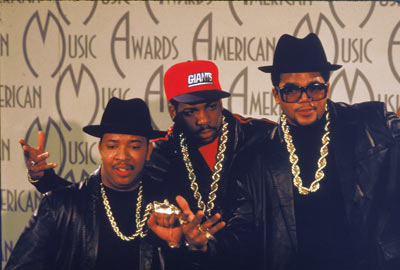
Fotos International/Getty Images
Run-D.M.C. at the American Music Awards, 1980s. Left to right, Joe Simmons (Run), Jason Mizell (Jam Master Jay, 1965-2002) and Darryl McDaniels (DMC).
Kool Herc (Clive Campbell), became the founding father of hip-hop when he segued from tagging to turn-tabling. One of his first memorable gigs was a back-to-school party hosted by his sister. Flyers for the party listed Herc as the DJ. His name was fairly well known because of his tagging exploits, so the party had a large turnout -- people showed up to get a glimpse of Kool Herc [source: Gross].
Partygoers quickly found out that Herc wasn't like other DJs. He didn't merely ensure a steady stream of tunes. By watching the crowds, Herc realized there were portions of songs that were better for dancing. People waited to dance until these instrumental breaks or beats would play. To solve this problem, Herc used two turntables and two copies of a record. He would switch back and forth, playing the same portion of the song repeatedly. This became known as breakbeats. Herc's toasting also increased the enthusiasm of the crowd -- with shout-outs like "Rock on my mellow," Herc encouraged partygoers to keep moving [source: Hebdige].
Over time, DJing became more difficult and required more attention -- so much so that Herc had little time for toasting. Emcees (MCs) Coke La Rock and Clark Kent came to Herc's aid (they would later be called The Herculoids). Coke La Rock expanded his toasting to full-fledged poems, and rapping was born. Coke La Rock and Clark Kent -- and sometimes even Herc -- also added dancing to the show. Free-style dancing was popular, and during the extended breaks, some dancers would go particularly wild. These were the first b-boys -- a moniker Herc coined. We'll talk more about dance in the section on hip-hop movement.
Soon, the DJ scene started to explode with talent. Afrika Bambaataa (Kevin Donovan) and Grandmaster Flash (Joseph Saddler) are seen as the godfathers of hip-hop. Bambaataa, a former member of the Black Spades street gang, witnessed firsthand what gang life was doing to people in his community. Through the creation of the Zulu Nation, Bambaataa planned to rid communities of violence and drugs and replace them with the positive elements of hip-hop. Today, Bambaataa remains an ambassador of hip-hop culture.
Inspired by his father's collection of music, Grandmaster Flash took his knowledge of electronics and put it to history-making use as a DJ, helping make several contributions to hip-hop:
- Punch phrasing is a little like a breakbeat but can use two completely different records. Dick Hebidge writes in "Cut'n'Mix," "the dj hits a particular break on one deck while the record on the other turntable is still playing. The punch works in hop hop like a punctuation mark in a sentence … [and] can be used to accentuate the beat and the rhythm for the dancing crowd."
- Scratching is the process of moving a record back and forth while it's playing -- the needle is in a groove, so it doesn't really scratch the record.
- Beat box is different from beatboxing or human beat box, the vocal percussion popularized by the Fat Boys, Doug E. Fresh and Biz Markie. Flash created the beat box by wiring a drum machine to his setup, "so you couldn't tell where the music stopped and I started" [source: George].
These and other pioneers carried hip-hop through house and street parties until the 1980s. Then, with the first recordings of hip-hop music, the scene started to move to larger venues and people's homes. The first hip-hop radio show, Mr. Magic's "Rap Attack," premiered on WBLS-FM in New York City in 1983. MCs became more prominent figures, sometimes replacing the DJ as the front man. The intent of the music also started to shift -- we'll look at how in the next section.
Modern Hip-hop
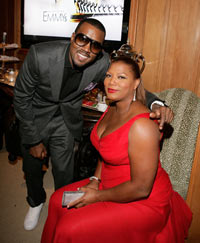
Mathew Imaging/FilmMagic
Kanye West and Queen Latifah at the 59th Primetime EMMY awards
While Grandmaster Flash and The Furious Five, Afrika Bambaataa and some of the other hip-hop pioneers were hitting the recording studios in the 1980s, a new guard of hip-hop artists started to appear. Hip-hop was crossing boundaries, making appearances in new wave and punk music. Both Blondie's "Rapture" and The Clash's "The Magnificent Seven" incorporated hip-hop stylings. Run-D.M.C. melded rap with hard rock. Artists like LL Cool J, Whodini, and The Beastie Boys created a variety of hip-hop music.
The industry changed along with the sounds. Sugar Hill Records, the premier label of hip-hop, died, but Def Jam Records and other hip-hop labels moved in. Female rappers like Salt-N-Pepa, Queen Latifah and MC Lyte broke the gender line, making it easier for female artists to come like Mary J. Blige and Lauryn Hill. Black Nationalism took center stage in Public Enemy's lyrics. The soundscape of hip-hop expanded from New York and the northern East Coast to the West Coast. In 1988, hip-hop made TV -- MTV that is -- with the new show, "Yo! MTV Raps." About a year later, rap videos could be seen throughout the day on MTV.
Artists like Schoolly D, Ice T, N.W.A. and Snoop Doggy Dog (now just Snoop Dog) brought gangsta rap to the scene. As gangsta rap gained widespread popularity, the original hope of hip-hop's message got lost in the mix. Gangsta rap glorified gang violence, poverty and the insidious drug trade rather than denouncing them. Misogyny reigned supreme as women were objectified and depicted as "bitches and hos." For example, according to N.W.A.'s gangsta rap hit "Gangsta, Gangsta," "life ain't nothing but bitches and money."
Alongside the gansta-themed stylings were artists more interested in socio-political statements and black pride, while others still were just about entertaining rhymes and good dance music. Some of the popular hip-hop artists during this time were: Wu Tang Clan (and its subsequent soloists Ghostface Killah, Masta Killa, Method Man, Ol' Dirty Bastard and RZA), Tupac Shakur (2Pac), N.W.A. (and its subsequent soloists Eazy-E, Ice Cube and Dr. Dre), Warren G, Sir Mix-a-Lot, KRS-One, Cypress Hill, and Mos Def.
Music Sales 2006
Although hip-hop is decidedly popular throughout the United States, according to the 2006 Consumer Profile released by the Recording Industry Association of America (RIAA), rock and country beat out hip-hop -- at least by official sales records. Here's the overall breakdown:
| Rock | 34 percent |
| Country | 13 percent |
| Rap/Hip-hop | 11.4 percent |
| R&B/Urban | 11 percent |
| Other | 7.3 percent |
| Pop | 7.1 percent |
| Religious | 5.5 percent |
| Children's | 2.9 percent |
| Jazz | 2.0 percent |
| Classical | 1.9 percent |
| Oldies | 1.1 percent |
| Soundtracks | 0.8 percent |
| New Age | 0.3 percent |
[source: RIAA]
Meanwhile, other sub-genres like progressive rap, Miami bass, New Orleans bounce, snap music, rap-metal (or rapcore) and crunk made the scene. Many of these came not from the northern East Coast or the West Coast, but from the southern United States. Perhaps one of the first groups from the south to gain mainstream acclaim is 2 Live Crew (think of the hit single "Me So Horny"). Some other southern artists include: the Geto Boys, Arrested Development, OutKast, David Banner, Ludacris, Mystikal, TLC, Timbaland, Lil John and the East Side Boyz, and Missy Elliot.
Today, hip-hop music is still going strong. Several artists who found their footing in the 80s and 90s are still prolific, selling CDs and singles alongside artists who appeared in this century, such as Eminem, 50 Cent, Busta Rhymes, Juelz Santana, Akon and Nelly.
And the message of the music just might be changing again -- or at least expanding to include more than materialism, violence and the objectification of women. Darryl McDaniels (formerly of Run-D.M.C.) said this in a TIME interview:
- This past decade it seems like hip-hop has mostly been about parties and guns and women. That's fine if you're in a club, but from 9:00 a.m. till I went to bed at night, the music had nothing to say to me. So I listened to classic rock.
Kanye West brought him back from his rock reverie with the song "Jesus Walks." On hearing the song for the first time, McDaniels said, "I thought, "This song is about everything! This feels alive!" [source: Tyrangiel].
Next, we'll look at how hip-hop has inspired movement.
Hip-hop Dance
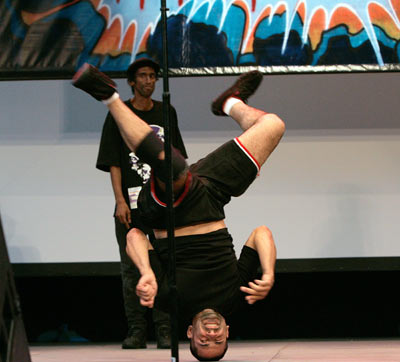
Jemal Countess/WireImage
Mr. Freeze of the Rock Steady Crew onstage at the Wild Style 25th anniversary celebration at Rumsey Field in Central Park on July 29, 2007 in New York City
Depending on how old you are, when someone says "hip-hop dance," you could picture the boogaloo, locking, popping, freestyle, uprocking, floor- or downrocking, grinding, the running man, gangsta walking, krumping, the Harlem shake or chicken noodle soup. And, of course, you could think about breaking, also called breakdancing.
Some of breakdancing's more memorable moves include headspins, handspins, backspins, the windmill (the breaker spins around on his upper body with his legs whirling around above him like the blades of a windmill), the worm, and the suicide (a standing back flip that ends with the dancer flat on his back or bottom). While arguably not the first hip-hop dance form, it got lots of media attention at the start of the hip-hop movement.
B-boys and B-girls
According to Kool Herc, a b-boy isn't just a dancer -- he can be anyone with that "Yo, I'm ready to break on somebody" attitude. Today, the terms b-boys and b-girls refer to skilled hip-hop dancers.
To understand how breaking came to be, you have to do a little legwork. As with the music that inspired the dancing, breaking's history begins with the slave trade. Slaves carried a mix of traditions from many West African countries to North and South America. Several key elements of African-American dance appear in popular dance today, including all-over body movement, earth-oriented movement, improvisation and pantomime [source: Kansas City Lindy Hop Society].
A number of popular African-American dance styles emerged through the mid-to-late 1800s and the early 1900s. Several migrated from the African-American community to the Caucasian community, including:
- The Cakewalk, competitive line dance
- The Charleston, which would later lead to an entire era of swing dancing
- The Black Bottom, a precursor to tap, jazz and swing dancing
Next came the Lindy Hop, followed by the Jitterbug, Savoy Swing and a number of other swing styles. Eventually, funk and disco were all the rage.
All of these styles have influenced modern hip-hop dancing, including breaking. But there were other influences as well. Afro-Caribbean dance was an inspiration, as was the Brazilian martial art form Capoeira. Other martial arts had a big impact, too. Kung fu films were a huge hit in the United States in the 1970s, so it's not a surprise that the movements of Bruce Lee and Jackie Chan were emulated and integrated into some of the earliest breaking moves.
In an interview for The Source, Afrika Bambaataa suggests that breakdancing started among street gangs with a dance called "Get on the Good Foot" by James Brown. In the interview, Bambaataa, Kool Herc and Grandmaster Flash also discuss how dancers started placing bets with each other on skill. And, although the style of dance waxed and waned through the 1970s, several crews -- such as the Rock Steady Crew and the New York City Breakers -- kept breaking going and even took it to its next level, incorporating many of the highly acrobatic movements that would take center stage in the 1980s [source: George].
Breakdancing in the 80s
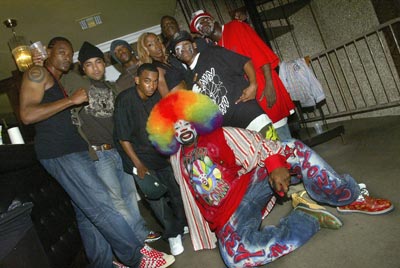
Matthew Simmons/Getty Images
Krump dancers from the documentary "Rize" pose with Tommy the Clown backstage at the launch party for the "Rock This Way" tour on June 29, 2005 in Hollywood, Calif.
By the mid 1980s, breaking was everywhere. The films "Wild Style," "Style Wars," "Breakin'," "Beat Street" and "Flashdance" all included breaking. During the 1984 Summer Olympics, breaking punctuated Lionel Richie's performance. Michael Jackson brought moonwalking (known as backsliding among the dancers who invented it) to the masses. Advertisers also took advantage of the dance craze -- everything from fast food restaurants to clothing lines used breaking as an ad backdrop.
Rock Steady Crew
Established in the Bronx in 1977 by Jimmy D and Jojo, the Rock Steady Crew has a 30-year history within the b-boy scene. During the 1980s, the crew performed in a variety of venues in the United States and abroad. Noted members Crazy Legs, Frosty Freeze and Ken Swift were instrumental in promoting the Rock Steady Crew to international acclaim.
Soon, it became more than a dance craze; it was a commodity. While some dancers were making money, they weren't the ones getting rich. Business-minded folks jumped into the fray with hip-hop clothing lines, guidebooks, video games, kneepads, special dance mats and other breaking-related items. According to a 1984 TIME magazine article, Wrangler was set to launch a collection called "Wrapid Transit," and Van Doren Rubber was putting out a special version of its Vans wrestling shoe designed especially for breaking [source: Koepp].
The breaking frenzy started to die down in the late 1980s. While it had disappeared from mainstream America, it wasn't entirely gone. Other hip-hop dances came to the fore and receded again. And then, in the mid to late 1990s, there was a resurgence in the popularity of breaking in the United States, and it has stayed within sight ever since. However, it's now part of a larger mix of hip-hop dancing. While some practitioners stay true to the old-school style, many incorporate other styles from the past and present, including popping, locking, funk, house, freestyle and more.
One of the newer hip-hop dances is krumping. Mentioned more than a few times on season three of the hit TV show "So You Think You Can Dance," krumping combines breaking, clowning, modern dance and even tap. If you'd like to see the moves firsthand, you can check out "Rize," David LaChapelle's "musical documentary."
In the same way hip-hop music inspired hip-hop dance, hip-hop dance styles have had an impact on another element -- hip-hop fashion. Read on to find out why suspenders weren't just for Robin Williams in the 1970s and who was sporting Kangols before Samuel L. Jackson.
Hip-hop Fashion
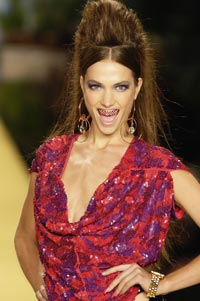
Karl Prouse/Catwalking/Getty Images
A model sporting a grill walks the runway at a Baby Phat fashion show in New York City.
Fashion is fickle -- styles come, go and come back again in the blink of an eye. Hip-hop fashion is no exception. In the beginning, DJs were the leaders of hip-hop style. Many took fashion cues from the disco styles surrounding them, while others developed styles of their own. As graffiti and breaking united with music to create the beginnings of a cultural movement, eyes started to focus on the MCs and breakers.
At first, most breakers dressed for comfort and practicality. Loose-fitting pants (sometimes with suspenders), comfortable sneakers (with the laces left mostly undone) and colorful t-shirts (to go with other members of a dancer's crew) were standard on the East coast. Meanwhile, military-inspired outfits with baggy pants (again, sometimes with suspenders) and lace-up boots were popular with some dancers on the West coast.
When Run-D.M.C. hit the scene, so did a look that would, at least in part, be emulated for years: black leather jackets and pants, black fedoras or Kangol hats, large, chunky chains and, of course, Adidas. Eventually, these leather "suits" made way for nylon and cotton tracksuits, still adorned with heavy jewelry. The ensemble was often topped with a Kangol or baseball cap and bottomed with a pair of designer athletic shoes (Adidas made way for Nike). African-inspired clothing also enjoyed a surge of popularity. Kente cloth from Ghana appeared in almost every type of apparel, and red, yellow, black and green were the colors du jour. Hats, and even entire outfits, were worn backward (remember the Kriss Kross video "Jump"?). Basketball jerseys were worn over t-shirts with jeans so baggy that they pooled in a puddle of fabric stopped only by the open, unlaced top of a Timberland or Lugz boot.
Love (and Life) is Strange
In a genre primarily run, produced, written and sung by men, it's surprising to discover that a woman was behind the first hit rap recording. Sylvia Robinson was co-founder and co-owner of Sugar Hill Records. Robinson had her own hit at the age of 14. In 1957, Mickey & Sylvia's "Love is Strange" garnered No. 1 on the R&B charts and made it to No. 11 on the pop charts. If you're having trouble conjuring up this tune, a little "Dirty Dancing" might help. Recall the scene where Jennifer Grey and Patrick Swayze mime the lyrics to the song playing in the background? That's the Mickey & Sylvia hit.
As the 1990s came to a close, oversized was still the size of choice, be it denim or cargo pants. The gangsta style of wearing pants so low that underwear shows persists today. Reportedly, the practice comes from prisons, where belts aren't allowed due to potentially lethal uses [source: CNN]. Kangol hats remain, as do baseball caps. Joining them is the do-rag, reportedly another prison-wear influence.
Gangsta-inspired clothing wasn't the only 90s hip-hop staple. Designer labels, such as Tommy Hilfiger and Ralph Lauren, filled closets from the East to the West Coast. The label-heavy trend remains today. Some of the more prominent brands on the shopping list include: Baby Phat, Carhartt, Converse, Dickies, Ecko and Ecko Red, Fubu, G-unit, Lacoste, Phat Farm, Reebok, Rocawear, Sean John, and Von Dutch.
Some of these didn't originate in the fashion industry -- they started within the hip-hop industry. Probably the oldest label is Russell Simmons' Phat Farm. The original hip-hop mogul's holdings are reportedly worth close to $325 million [source: Katel]. Jay-Z sold Rocawear for $204 million and purchased another clothing line, Artful Dodger, for $15 million [source: Brown].
Clothing isn't the only big business associated with hip-hop. Accessories -- particularly jewelry -- bring in the Benjamins, too. Long before the word "bling-bling" ("bling" for short) was coined, Kurtis Blow gave gold a good name by donning several chains, some with medallions, at once. Run-D.M.C. and others took it a step further and beefed up the gauge of the gold, wearing incredibly thick chains that resembled actual rope. As time went on, jewelry became more elaborate, and gold gave way to platinum -- of the iced-out variety, encrusted with diamonds.
For those so inclined (not all hip-hoppers adorn themselves), there's jewelry for almost every body part. Multiple-finger rings can double as a set of super-expensive, not-so-brass knuckles. Belly chains can complement a navel ring. Even teeth can go gold or platinum. While some early hip-hop artists went in for simple gold caps, today's stars can have extra sparkle and shine with a grill.
From graffiti to grills, hip-hop is one of the most influential cultural movements ever to transpire in the United States -- and its impact isn't confined to one continent. Next, we'll take a look at how hip-hop has spread.
Globalization of Hip-hop
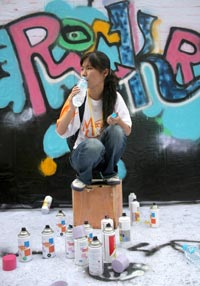
China Photos/Getty Images
A Chinese girl drinks water after finishing graffiti on a wall during the Chengdu Hip Hop Culture Festival.
A little international travel will quickly show you that hip-hop has gone global. From Brazil to England to France to Japan to India to South Africa, young (and some old) people are finding a voice, a sense of style and even a sense of self in hip-hop. While it might appear as though people have shallowly appropriated the style and sounds and aren't truly feeling the movement, this isn't necessarily so. Sure, there are those -- what some Americans would call imitators or wannabees -- who are merely moving through the elements of hip-hop on their way to the next Western pop culture import, but others are integrating the movement into their own local situation.
In an article titled "Japanese Hip-Hop and the Globalization of Popular Culture," Ian Condry mentions how strange it can be to fly from New York to Tokyo and find teens decked out in the same hip-hop style as those he just saw in the United States. But he points out that, while everything seems the same, it's not. The borrowed hip-hop culture is imbued with local cultural dynamics. The local b-boys and b-girls have added their regional flavor to the mix [source: Condry].
In Italy, where hip-hop culture and rap music have had a strong and growing following for more than two decades, rappers rhyme in their local dialects. According to a New York Times article, "Nearly 50 percent of all Italians still speak in dialect, at least within the family, and the musicality of most dialects adapted well to the rhyme and cadence of rap." The subject of Italian rap music, while more recently is concerned mostly with love and other conventional topics, has included everything from the Mafia to government corruption to homelessness to drug addiction -- in Italy, not New York [source: Povoledo].
Musical movements have made their way across geographical divides before, but hip-hop is more than just music -- it's a way of life that encompasses physical movement and personal expression. As S. Craig Watkins writes, "Yes, hip-hop has been an astonishing moneymaker, but it has been an equally astonishing source of youth expression and empowerment" [source: Watkins].
Hip-hop's wide reach is also tied to the commercialization of the movement. Watkins points out that record companies, fashion labels, sports franchises, and even food and beverage companies are all selling their products by advertising the hip-hop lifestyle, and how their shoes, soda or sandwiches fit into it.
Another key element that's helping spread the hip-hop word is the Internet. At no other point in history have people living in such disparate circumstances and in separate points of the world been able to come together to communicate like they can today. One Web site, Global Grind, aims to be the "ultimate online destination for the hip-hop community" [source: Global Grind]. Navarrow Wright's baby is backed by some heavy hitters, one from hip-hop and one from the online community: Russell Simmons' Island Def Jam Music Group and Facebook investor Accel Ventures [source: Holahan].
Global Grind isn't the only hip-hop hotspot on the information superhighway. Other hip-hop-minded social networking sites include BlockSavvy and DanceJam. BlockSavvy is like MySpace. DanceJam, which is co-founded by MC Hammer, goes a step beyond social networking and includes slow-motion dance tutorials. The site plans to launch regional features, which could have a huge impact on dance styles around the globe. Reportedly, the site's founders hope that eventually its users will "be able to look up any major city on DanceJam and learn the hottest moves in the area before booking a trip" [source: Van Buskirk]. Visiting the site could give a completely new meaning to the old catchphrase, "It's Hammer time!"
For more on hip-hop, music and related topics, see the links on the next page.
Lots More Information
Related HowStuffWorks Articles
- How Cutting Your Own CD Works
- How Pandora Radio Works
- How the Grammys Work
- How MP3s Work
- How MP3 Players Work
- How Jazz Works
- How Voodoo Works
- How Spanglish Works
- How Street Gangs Work
More Great Links
- Global Artists Coalition: Hip-hop History Exhibition
- Global Grind
- BlockSavvy
Sources
- Abdollah, Tami. "Wanna be in pictures? Tag in Montebello" Los Angeles Times, November 15, 2007
- Austin, Joe. Taking the Train: How Graffiti Art Became an Urban Crisis in New York City. Columbia University Press, New York © 2001
- Baggy Pants Crackdown Goes National
http://www.cnn.com/2007/US/09/17/baggy.pants.ap/index.html - Brown, Ann. Jay-Z Expands Fashion Portfolio
- Rocawear founder buys designer label Artful Dodger, Black Enterprise, November 27, 2007
http://www.blackenterprise.com/cms/exclusivesopen.aspx?id=3832 - Condry, Ian. "Japanese Hip-Hop and the Globalization of Popular Culture" Urban Life: Readings in the Anthropology of the City. ©Waveland Press
- Ehrlich, Dimitri and Ehrlich, Gregor. "Graffiti in Its Own Words: Old-timers remember the golden age of the art movement that actually moved." New York Magazine Summer Guide, June 25, 2006
- George, Nelson. "Hip-Hop's Founding Fathers Speak the Truth" from That's the Joint: The Hip-Hop Studies Reader, Murray Forman & Mark Anthony Neal, editors, Routledge, 2004
- Gobal Grind Web site: http://www.globalgrind.com/
- Gross, Terry. "Kool Herc: A Founding Father of Hip Hop," audio interview from Fresh Air WHYY, March 30, 2005.
- Hebdige, Dick. Cut 'n' Mix: Culture, Identity and Caribbean Music. Methuen & Co. 1987
- Holahan, Catherine. "Hip-Hopping the Digital Divide," Business Week Online, Nov. 13, 2007
- http://www.kclindyhop.org/history_a.htm
- Katel, P., "Debating hip-hop." CQ Researcher, June 15, 2007 pgs. 529-552
- Koepp, Stephen. "Breaking Through to Big Profits," TIME Magazine, October 1, 1984. http://www.time.com/time/magazine/article/0,9171,954411-1,00.html
- MacGillivray, Laurie and Curwen, Margaret. "Tagging as a social literacy practice," Journal of Adolescent & Adult Literacy; Feb2007, Vol. 50 Issue 5, pgs. 354-369
- NEWSWEEK, "Clownin' Around," Web exclusive, Oct. 2007 http://www.newsweek.com/id/49915/output/print
- Povoledo, Elisabetta. "In Italy, a Long Tradition of Homegrown Hip-Hop," New York Times. (Late Edition (East Coast)). New York, N.Y., Jul 23, 2000
- RIAA 2006 Consumer Profile
http://www.riaa.com/keystatistics.php?
content_selector=consumertrends - "'Taki 183' Spawns Pen Pals," New York Times, July 21, 1971, pg. 37
- Trebay, Guy. Taking Hip-Hop Seriously. Seriously. New York Times. May 20, 2003
- Tyrangiel, Josh. "Why You Can't Ignore Kanye," TIME Magazine, August 21, 2005
- Van Buskirk, Eliot. "MC Hammer Hops onto Dance Craze with DanceJam," Wired , November 12, 2007
- Watkins, S. Craig. "Why Hip-Hop Is Like No Other," Foreign Policy, November/December 2007.
Hip Hop Poetry and the Classics Pdf Answer Key
Source: https://entertainment.howstuffworks.com/hip-hop.htm